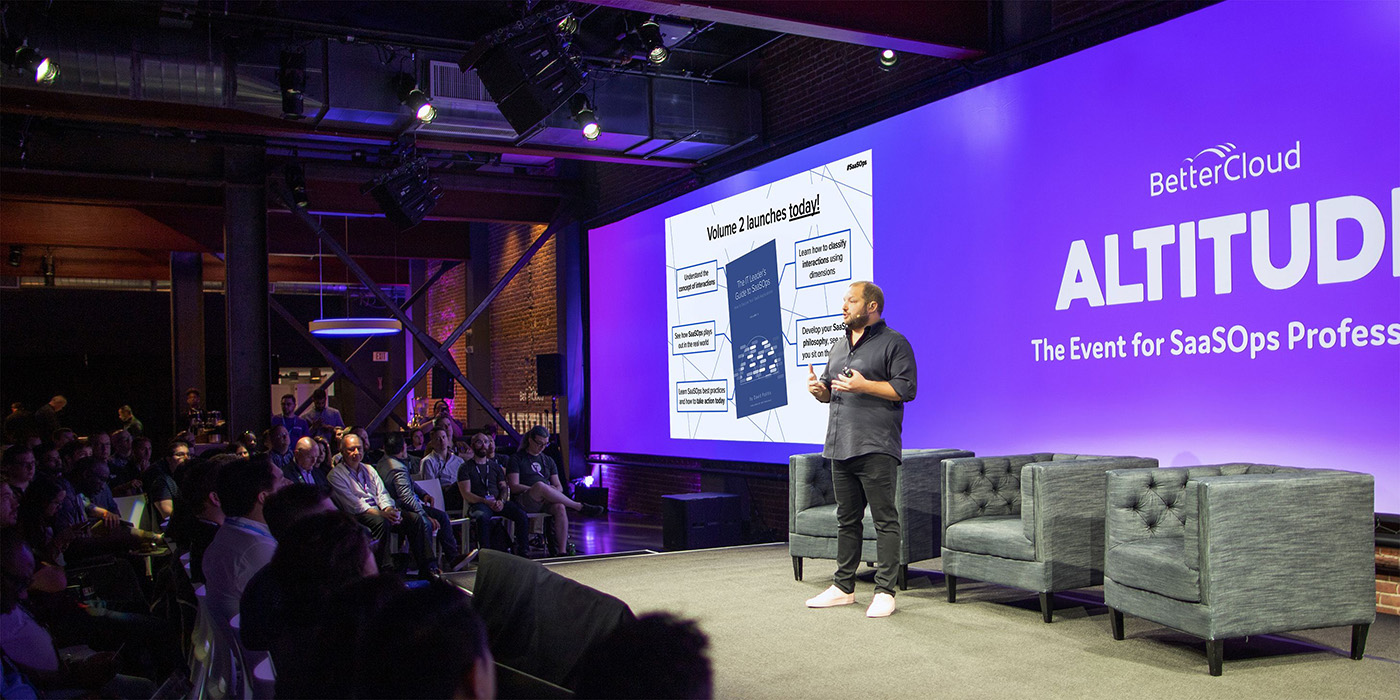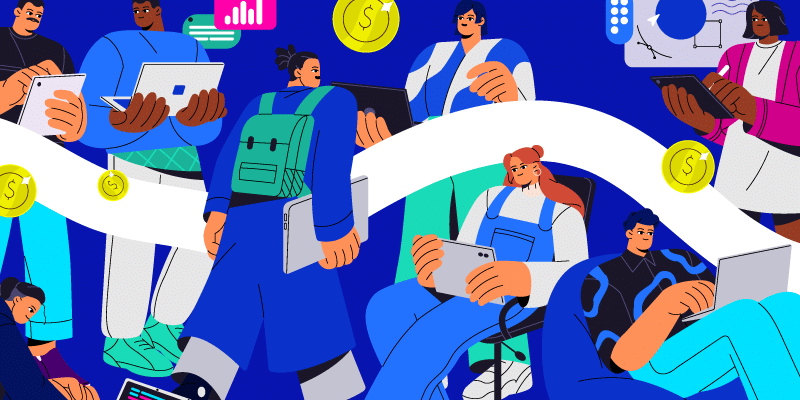Introducing My Second Book: The IT Leader’s Guide to SaaSOps (Volume 2)
January 6, 2020
5 minute read

I’m thrilled to announce the release of my second book, The IT Leader’s Guide to SaaSOps (Volume 2): How to Secure Your SaaS Applications.
In today’s digital workplace, SaaS platforms only secure their applications. You, the IT leader, must secure how they’re used. This book is a deep dive into how to do that—with the help of a new category and movement called SaaSOps.
“Part horror story, part Bible, part motivational manual. It’s the how-to guide for securing budget approval to manage and secure your SaaS apps.” —Colin McCarthy, VP of Global IT at Essence
It’s packed with real-world stories, new research, a tactical checklist, and a SaaSOps action plan to help you get started securing your SaaS data. There’s even a 25-question quiz so you can assess where you land on the SaaSOps philosophy spectrum.
Two sides of the same SaaSOps coin
Three years ago, I wrote my first book, The IT Leader’s Guide to SaaSOps (Volume 1): A Six-Part Framework for Managing Your SaaS Apps. Up until that point, there had been no guiding principles for managing enterprise SaaS. So I created this six-part framework, the first of its kind, based on interviews, surveys, and conversations with thousands of IT professionals who are deploying and managing SaaS apps. It was really the product of your collective experiences, learnings, and challenges.
Volume 1 was very well-received. But in conversations with people about it, the question that kept coming up was: “How is IT securing their environments? What are you seeing most people do?”
So last year, I started writing my second book on securing SaaS, a topic that’s arguably even more important than managing your SaaS applications.
Together, the books are two sides of the same SaaSOps coin.
What’s in this book
After reading Volume 2, you’ll:
- Understand a new concept called user interactions (and why they’re the key to securing the digital workplace)
- Learn new tactics for securing SaaS data
- Develop your own SaaSOps philosophy and see where you sit on the spectrum
- See how SaaS security challenges play out in the real world
- Be equipped with a comprehensive checklist for SaaSOps best practices
- Have an action plan for securing your SaaS data today

Figure 17 from the book. The SaaSOps Philosophy Spectrum illustrates the range of philosophies on how to secure user interactions.
Volume 2: “We are experiencing everything this book talks about”
While Volume 1 is more high-level and theoretical, Volume 2 gets right in the weeds. It’s much, much more tactical.
It’s a pretty easy read. Read it over the weekend, and when you’re done, you’ll be able to defend the need to secure SaaS apps. One of our customers told me:
“This is a very modern book. It’s the easiest way to explain SaaS to people who’ve been in the tech industry for 30+ years.”
Before the book was officially published, I gave a small group of customers a sneak peek of the manuscript, and we discussed it over dinner. What really struck me was how everyone there, regardless of industry or company size, identified with SaaSOps. They were all tackling the same exact challenges around SaaS management and security, which tells me that we’ve reached a tipping point. This is what a few people said that evening:
-
- “Thorough with a nice balance of anecdotes and research. I found the entire book very relatable.”
-
- “An illuminating read. It’s validating to see that other IT professionals are on the same SaaSOps path.”
-
- “The concept of SaaSOps is very relevant in today’s IT operations. In fact, I’m planning to head up a SaaSOps team.”
-
- “We are experiencing everything this book talks about.”
Why write two books?
I get asked this question a lot. Not many CEOs have literary aspirations (or the time to write much). It’s not easy. The process starts with me locking myself in a room for two days straight, just getting all my thoughts out on paper. Then it takes months of writing, researching, getting feedback along the way, refining, weaving in stories I’ve heard from customers, etc.
All in all, the whole process takes me about a year per book. It’s definitely a labor of love. But I felt very strongly about writing these books for a few reasons:
1) First and foremost, it’s for our customers. My goal was to give our customers a voice. Having been in this space for 10 years (8 at BetterCloud, 2 at Cloud Sherpas before that), I wanted to share what I’ve been hearing from many IT pros and share it with others. Most modern IT professionals are on an island—they’re trying to figure this out on their own. Nobody else in their org has probably ever had to deal with these SaaSOps challenges. I wanted to be that connective tissue and bridge knowledge gaps. It was important to me to share all these challenges (and offer guidance) in a tangible, concise, and complete way.
Fostering knowledge sharing for IT has always been part of BetterCloud’s DNA. That’s why we have our BetterIT Slack community, the daily Monitor newsletter, and our annual SaaSOps conference, Altitude. We believe the best way to navigate uncharted territory is through the power of community, with each other’s help. For the past 8 years, our customers have been blazing new trails, learning from each other, and figuring out solutions together. This book is just another way to help with that.
2.) It gives our team a purpose and mission. Every new BetterClouder receives a copy of the books. It’s important to me that everyone at BetterCloud understands the “why” of their work. I want them to see why their work matters and why we’re on this mission together. Their contributions are helping solve major challenges for IT and enabling them to transform their workplaces.
3.) It educates the market. From an industry perspective, SaaS operations is only just now starting to pick up steam. But if we want best-of-breed to be successful, the market needs to take notice. Vendors like Slack and Zoom are only going to continue building their infrastructure and expanding their functionality. The more they grow, the more IT needs to control how those apps are used. If that’s not done properly, best-of-breed will be derailed. We’ll have no choice but to revert back to using homogeneous toolsets from a single vendor.

Figure 18 from the book. The tradeoff between productivity and security, and the equilibrium in the middle.
For years, I’ve always felt like we were swimming upstream, going against the grain, seeing a future that few others saw. I started BetterCloud eight years ago, before products like Slack, Zoom, and Office 365 even existed. When I explained what we did, people didn’t understand what I was talking about, why it was necessary, who would use it. We had to shout it from the rooftops.
Now, we’ve finally reached a tipping point. SaaSOps has hit critical mass. The operational challenges for IT are real, they’re growing, and there’s enough of them to fill two books. Now the next step is to start solving these challenges, which I hope these books help you think through.
If you have any feedback on the book, have ideas for the next one, or just want to discuss SaaSOps, I’d love to hear from you. Feel free to email me at dave@bettercloud.com.
To learn more about The IT Leader’s Guide to SaaSOps (Volumes 1 and 2) and get a copy, check out https://www.bettercloud.com/saas-books/.
Join David on his book tour and chat about SaaSOps with the author himself! 2020 tour dates include stops in San Francisco and Costa Mesa, with more to be announced. Learn more and register here: https://www.bettercloud.com/events/.







